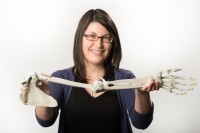Unique Anatomical Kit Contains Parts Produced by 3D Printing
Monday, 14 July, 2014

The creators of a unique kit containing anatomical body parts produced by 3D printing say it will revolutionise medical education and training, especially in countries where cadaver use is problematical.
The ‘3D Printed Anatomy Series’, developed by experts from Monash University, is thought to be the first commercially available resource of its kind. The kit contains no human tissue, yet it provides all the major parts of the body.
Professor Paul McMenamin, Director of the University’s Centre for Human Anatomy Education, said the simple and cost-effective anatomical kit would dramatically improve trainee doctors’ and other health professionals’ knowledge and could even contribute to the development of new surgical treatments.

“For centuries cadavers bequested to medical schools have been used to teach students about human anatomy, a practice that continues today. However many medical schools report either a shortage of cadavers, or find their handling and storage too expensive as a result of strict regulations governing where cadavers can be dissected,” he said.quired to teach anatomy of the limbs, chest, abdomen, head and neck.
“Without the ability to look inside the body and see the muscles, tendons, ligaments, and blood vessels, it’s incredibly hard for students to understand human anatomy. We believe our version, which looks just like the real thing, will make a huge difference.”
The kit, which is set to go on sale later this year, could have particular impact in developing countries where cadavers aren’t readily available, or are prohibited for cultural or religious reasons.
“Even when cadavers are available, they’re often in short supply, are expensive and they can smell a bit unpleasant because of the embalming process. As a result some people don’t feel that comfortable working with them,” Professor McMenamin said.
“Our 3D printed series can be produced quickly and easily, and unlike cadavers they won’t deteriorate – so they are a cost-effective option too.”
After scanning real anatomical specimens with either a CT or a surface laser scanner, the body parts are 3D printed either in a plaster-like powder or in plastic, resulting in high resolution, accurate colour reproductions.
“Radiographic imaging, such as CT, is a really sophisticated means of capturing information in very thin layers, almost like the pages of a book. By taking this data and making a 3D rendered model we can then colour that model and convert that to a file format that the 3D printer uses to recreate, layer by layer, a three-dimensional body part to scale,” Professor McMenamin said.
The research team is currently negotiating with potential commercial partners.
Further details have been published online in the journal Anatomical Sciences Education.
2025 WA Nursing and Midwifery Excellence Awards finalists
The 2025 WA Nursing and Midwifery Excellence Awards finalists have been announced, celebrating 41...
Northern Beaches Hospital nurses and midwives go on strike
Nurses and midwives at the NSW hospital now part of a parliamentary inquiry went on a 26-hour...
Nominations are open for Australia's nursing trailblazers
Until 31 March, nominations are open for the Health Minister's Award for Nursing...









